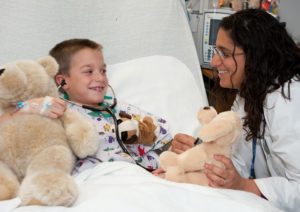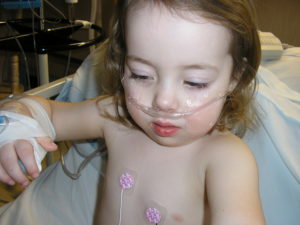July 26th, 2017
When a Child Receives Care at a non-Children’s Hospital
Emily F. Moore, RN, MSN, CPNP-PC, CCRN

Emily F. Moore, RN, MSN, CPNP-PC, CCRN practices pediatric cardiovascular care across the Pacific Northwest.
In a recent post, I wrote about my niece’s episode of appendicitis. Another part of that story relates to her post-op course. When my sister first called asking my advice on whether or not her daughter needed to be treated, I didn’t specify where she should take her. She ended up going to a general hospital with a pediatrics unit. There, my niece was treated by surgeons and other clinicians who primarily see adults. Here’s what happened.
Less than 24 hours after surgery, I arrived at the hospital to find her slumped over in bed with visible retractions and oxygen saturations around 88%. When I asked about pulmonary toileting and basic nursing care, such as ambulation, positioning, and rolling over in bed, I was told, “We aren’t bullies; we don’t make our kids do that.” When I asked how making a child deep-breathe and walk to prevent nosocomial complications like pneumonia was bullying, I was dismissed. Never one to let things lie, I kept asking questions, and I soon concluded that the institution itself was not familiar with basic pediatric care. Despite being only 8 years old, my niece still needed to sit up, walk, and use an incentive spirometer. (And since when is an oxygen saturation of 88% okay for anyone, assuming there are no signs of cardiopulmonary disease?)
My niece spent close to a week in the hospital and was sent home despite my sister’s concerns regarding things “just being off.” When my sister told the staff that she didn’t think my niece was eating well, she was reassured that this was normal and that discharge was the next step. At home, things continued to worsen, and two days later they returned to the emergency department for continued abdominal pain, diarrhea, and low-grade fevers. Once again, my sister’s concerns were dismissed, and after urine was dipped and “clear,” she was sent home, after being told that my niece was recovering and everything was okay. I was quite surprised that in the setting of postoperative pain and fever, an abdominal imaging was not done and labs were not sent. Two days later, my niece’s symptoms worsened, and I advised my sister to go to a children’s hospital.
Initially annoyed at me for suggesting another institution, my sister immediately saw why she needed to be there. From the animals on the walls to the different colors on the floor, it was clear to her the moment she walked in the door that the care would be more geared towards children. And from the moment they saw a physician, there was no question that the expertise had shifted from an adult provider who sees children to a pediatrics-focused specialist. When my sister first explained the course of events, she was listened to. The physician said, ‘I am sorry this has happened to you; not only is your daughter’s care our concern, but your comfort with her care is as well.” My sister was instantly put at ease and felt that they were in good hands. She thanked me for insisting that they drive the extra miles for my niece to be treated there.
My niece was diagnosed to have three bowel abscesses and a bowel fistula. She ended up being started on total parenteral nutrition and was hospitalized for an additional nine days. Her care team made sure that both my niece and my sister were ready when it came time to go home. Thankfully, this story has ended well for my niece, who is now active and healthy again.
 Working at a children’s hospital myself, I sometimes forget how different the worlds of pediatric and adult health care can be. I often go out into the community to educate first responders about pediatric heart disease, and I have realized that while treating kids is normal for me, many of them are uncomfortable with it. (The opposite is true for me… give me a kid any day! Adult-sized patients make me incredibly nervous and uncomfortable.) Also, as demonstrated in this case, a common theme in pediatrics is to treat the family, not just the patient. If a parent has a concern about his or her child, it is addressed. So, when this doesn’t happen in a clinical care setting, I am often surprised and taken aback. I strongly believe that parents know their children best. From my perspective as a pediatric care provider, if you are telling me that your child isn’t back to normal and just seems off, then we should probably take a step back and reevaluate the situation.
Working at a children’s hospital myself, I sometimes forget how different the worlds of pediatric and adult health care can be. I often go out into the community to educate first responders about pediatric heart disease, and I have realized that while treating kids is normal for me, many of them are uncomfortable with it. (The opposite is true for me… give me a kid any day! Adult-sized patients make me incredibly nervous and uncomfortable.) Also, as demonstrated in this case, a common theme in pediatrics is to treat the family, not just the patient. If a parent has a concern about his or her child, it is addressed. So, when this doesn’t happen in a clinical care setting, I am often surprised and taken aback. I strongly believe that parents know their children best. From my perspective as a pediatric care provider, if you are telling me that your child isn’t back to normal and just seems off, then we should probably take a step back and reevaluate the situation.
My niece’s limited care was likely related to the institution’s focus on adults rather than pediatrics. I know that there are many general hospitals with above-average pediatric units. However, this whole situation made me think, should there be more standard practices in place to ensure that children are well cared for everywhere? Should pediatric hospitalists be present at general hospitals? Or should more pediatrics training be conducted at these hospitals? Presumably more trainings and simulations would help ensure a high quality of care for children regardless of where they receive it.




As a PICU RN for 16 years & an FNP for 20 I absolutely agree. The standard of care has not been appropriate in many if not most community hospitals. I witnessed this first hand doing pediatric transports. I’ve worked in three university affiliated children’s hospitals & been involved in the national consortium of PICUs. The appropriate care of ALL pediatric patients is paramount, and as Emily’s account illustrates, even ‘routine’ surgeries can have complications. In my area we’ve seen the development of partnerships between local pediatric & NICU units & our children’s hospitals, which has improved timely access to specialty care. I’m no longer involved in policy development, but what’s the position of the AAP? Pediatricians, Hospitalists, ER docs, what do you think?
Elizabeth,
Thank you for your comments and insight. Your dedication to nursing is impressive.
Emily
Very well written and very important. Also scary. Keep it up!
Do you have some evidence to support your conclusion that the poor care your niece got was “likely related to the institution’s focus on adults rather than pediatrics?” Perhaps this institution provides similar care to adults.
Mark,
I do not know this to be fact. I have had adult family members admitted at this same institution and the care they received was far better than the care my niece received. However, you are correct, the care provided to adults may be similar.
Thank you for your comment,
Emily
This was terrific and my thanks for sharing. Certainly found this to be true when my nephew was at Children’s as preemie newborn.
All true as far as it goes. I’d add that for many of us in non-urban western locations the ‘extra miles’ may be 100 to 200 miles, and even a rotary-wing flight. That’s likely so in the PacNW I think. I’m fortunate to work in a hospital where newborn and pediatric care is a priority, in large part because we are 120-250 miles from alternatives. We DO listen to parents.
For many cases continued outreach and education between referral hospitals and their referring institutions helps a lot.
I’d wager that the hospital described here may struggle with unusual presentations and complications in adults as well.
If you treat (non-elderly) adults like large children you are usually OK.
-from Silver City, NM
Dr Williams,
Thank you for your insightful comments. I am happy to hear pediatric and newborn care is a priority at your institution.
Emily
Hello emily, sad to read the history of your niece. My view as a spec for grown up with intern med concerns is that the step for pediatric patients with chronic diseases to the follow up in grown up units is huge and I think it would benefits by having both the pediatrician care and the adult care under the same roof maybe with the help of a more spec centre as consult. I think that in this case the care of your niece was not correct – not even for adults who can get the same complications
scandinavian view
Robert